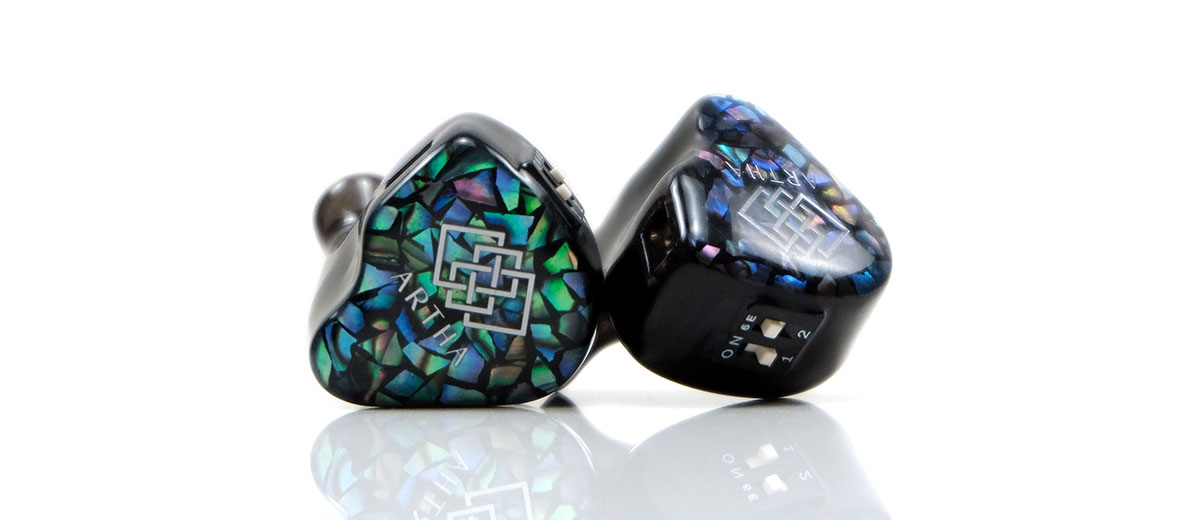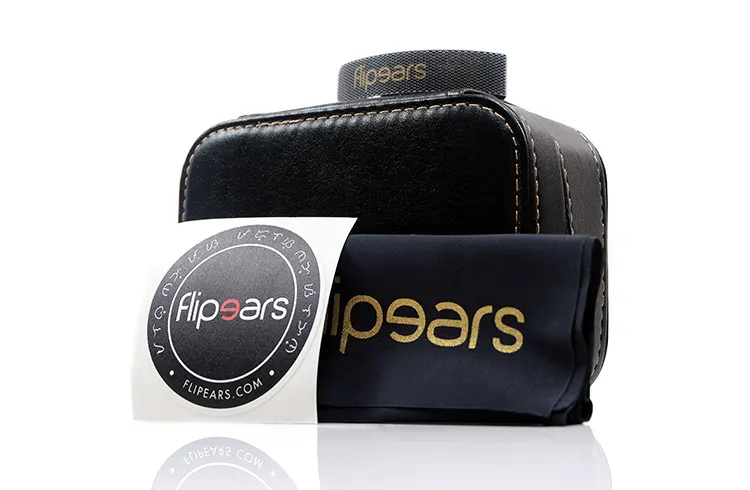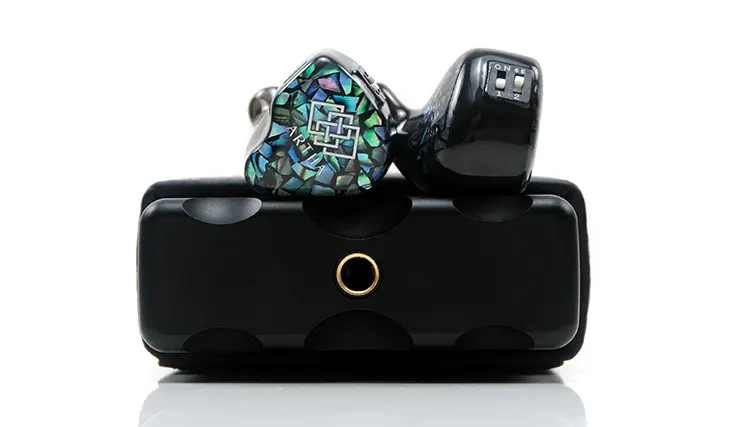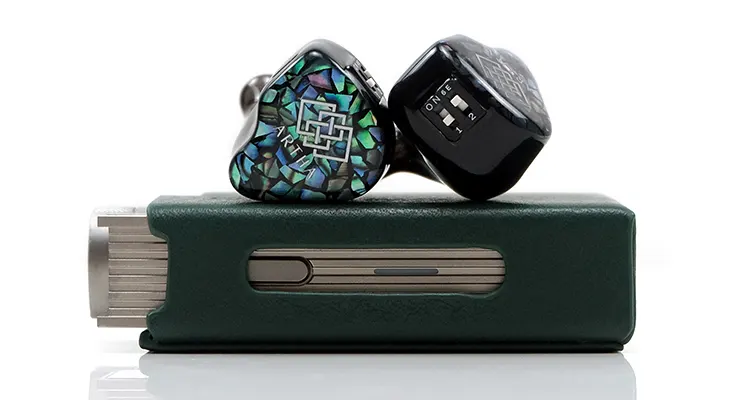Sound Impressions
The following sound impressions were completed using a mix of the HiBy R8 II and the iBasso DC-Elite in balanced low gain mode as my main source and amplification.
Summary
The ARTHA sound signature is a dip-switch-dependent tuning, meaning, you get 4 different sound signatures for the price of one.
That said, there is a core sound signature running throughout each configuration with the bass, upper-mids, and treble amplitude most affect from 20Hz up to 500Hz and again from 2k upwards.
The degree of change can be subtle from 1-2 dB to more dramatic at up to 5 dB through the lows.
On one end of the scale, the ARTHA is a gently U-shaped familiar BA sound signature with a neutral bass response sub-100Hz, strong pinna gain with forward vocal imaging, and a relaxed set of highs.
On the other end of the scale, it’s quite colored with an elevated, full-sounding bass shelf, plenty of warmth, a saturated even-harmonic vocal timbre front and center, and enhanced sparkle up top. You can go even further by darkening the top-end but I find this tuning the least accessible of the four.
The default dip switch tuning likely is where most owners will spend most of their time listening to the ARTHA. The general curve has a similar shape but is more nuanced in the degrees of bass and treble amplitude giving it a nice balance and excellent genre flexibility.
Here is where you begin to understand the tuning intent of the ARTHA combined with the mid-centric Baroque tips. This is a ‘vocal first’ monitor with a deep underlying bass response, and a nice touch of warmth that helps create a smooth vocal delivery.
The ARTHA also excels with neutral sources or those with great channel separation such as the Mojo 2 or the Cayin N7. It enjoys a clean signal and benefits from DAPs and dongles with good high-frequency extension.
Frequency Response
The ARTHA’s core frequency response (FR) has an emphasis on the lows up to 100Hz, a gradual drop into the lower mids from 250Hz to 1kHz, and a healthy pinna gain from 1-3kHz.
Beyond that, the upper mids and treble taper smoothly from around 4-5kHz onward, with a mild bump at 10kHz.
This results in a slightly darkened sound beyond the mids, emphasizing vocal and bass presence.
The tuning dip switches offer variations without diverging from the core FR. With both switches on, the bass shelf elevates by around 5-6dB from 20Hz to nearly 200Hz compared to the balanced mode (switch 1 on, switch 2 off).
This brings added power and body to the lows, slightly reducing vocal prominence, while giving lower-pitched instruments impressive gravitas.
For higher-pitched vocals, the “dual switch on” mode is dynamic and well-suited to modern pop and EDM, where the midrange mix often has more space.
The “Bass Boost On” mode (switch 1 on, switch 2 off) keeps the bass weight of the dual switch setting but tapers off treble from 4-5kHz onward, creating a dark, rounded tone that lacks enough air for vocals to fully shine.
For most users, the default configuration (switch 1 off, switch 2 on) provides a balanced sound, with the bass shelf dropping about 5-6dB from the extreme setting and leaving mids and highs relatively untouched.
This setup yields a clearer midrange and a slight lift at 8kHz, adding percussion impact and definition to the upper register.
With both switches off, the bass shelf reduces a few more dB up to 500Hz, resulting in a more neutral, though not flat, sound. It retains some warmth rising into the mids and preserves the lifted highs of the balanced mode, adding contrast and sparkle to the midrange timbre.
Staging & Dynamics
The ARTHA has excellent depth and power with a fairly forward vocal imaging experience relative to background instruments. The fundamental frequency should leave you wanting for nothing with dance, pop, R’n’B, or anything with a bit of energy in the lows.
Where it can struggle slightly is air and space in the mids and highs with that muted 5-7k tuning though this can be mitigated via sources and switches.
For example, the Questyle M15 produced a ‘hot mess’ with both switches on sounding congested in the mids with very little width or air. It is a more comfortable listening experience when the ARTHA is in balanced or HF mode.
Both the DC-Elite and Cayin’s RU7 coped admirably with the dual switch mode turned on, either through the former’s bloom control, dynamic range, and clarity or the latter’s excellent channel separation.
I would suggest pairing with a clean and dynamic source in general with the ARTHA to keep the mids as open and sounding as tall as possible to prevent the slight dip in the ARTHA treble from becoming too dark when bass boosting.
Synergy
Efficiency & Sensitivity
The FlipEars ARTHA is rated at 16Ω for impedance and has an SPL of 118 dB/mW @1kHz, making it fairly sensitive and easy to drive from DAPs and dongles in a low-gain balanced output mode.
It is less sensitive than all-BA high-end IEMs such as the Noble Audio Kadence and the Campfire Audio Fathom. However, it is much more sensitive than the older 25Ω and 100 dB/mV SPL Softears RS10 (see page 3 of this review).
For the record, the benchmarked 16Ω impedance rated is with the dip switched in their default balanced mode configuration. Since dip switches use impedance as a factor in their tuning there is a small amount of impedance variation when you change modes.
I spoke with FlipEars on this and was told the variation is not more than 2-4Ω from the 16Ω benchmark with roughly a 5 dB swing from the peak bass setting to the lowest so it’s not a big change.
DAP Pairings
I tested three DAPs including the HiBy R8 II, Cayin’s N7, the FiiO M15s, and the Chord Electronics Mojo 2 portable Amp/DAC. Out of these I had a clear preference for sources that offered a neutral bias in their tuning or a spacious soundstage.
For example, the Mojo 2 and the R8 II were the most neutral pairings. This is where the ARTHA sounded the most balanced and resolving with the upper mids and relatively relaxed treble tuning benefiting from a boost.
With these two sources, I got a nice clean treble, a bit of sparkle, and a taller staging quality injecting more air and clarity in the mids. The strong vocal imaging of the ARTHA is also kept in check helping to tease out instrumental presence and a deeper soundstage.
What you do not want is compression in the ARTHA mids and this is where I felt the M15s underperformed. The ARTHA/M15s pairing created a weightier more saturated tone, thickening up the base of the notes with a warmer even-harmonic frequency and clogging up the mids a bit more.
The resulting sound is euphonic but lacks the same clarity and air as the R8 II and Mojo 2 creating a more 2-dimensional quality to the presentation.
The N7 sits between the M15s and the two more neutral sources. It is still not my absolute favorite but a better bet than the M15s pairing.
It’s a fairly relaxed sound signature so it will not push the highs of the ARTHA out of their comfort zone. It gets away with this by stretching out the ARTHA soundstage and creating excellent separation and space for the mids to sound clear yet not too bright.
Dongle Pairings
I tested four dongles with the ARTHA including Cayin’s RU7, the DC-Elite from iBasso, HiBy’s FC6, and the Questyle M15.
The outcomes more or less followed the same pattern as the DAPs but this time I also wanted to see if changing up to full bass and treble mode (full switches on) would affect my preferences.
With both switches on, the M15 lasted about 10 minutes before it was placed at the back of the pile. It sounded like a congested mess with the ARTHA with overly bloated lows, claustrophobic mids, and a lack of separation with far less staging height and width than the DC-Elite and the RU7.
The FC6 did better with both switches turned on, offering excellent depth, power, and a little more midrange separation. However, it still lacks the space and holographic dimension of the iBasso and Cayin dongles for the ARTHA to truly shine.
Of the top 2 dongles, I could go either way depending on my mood and switch configuration. The DC-Elite retains the best clarity and dynamic range but at times I felt the RU7 offered the more spacious sound.
The DC-Elite does better filling in those upper mids and lower treble than the RU7 so if you turn on all the switches it keeps the bloom in check slightly more than the RU7.
However, for the balanced mode or the HF mode, particularly with the Baroque tips, the ARTHA sounds smoother and more natural with the RU7.





